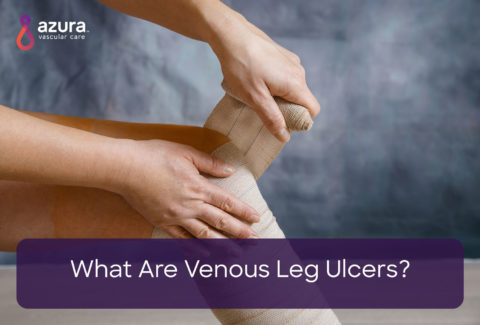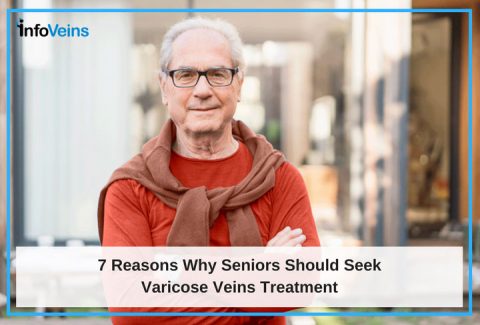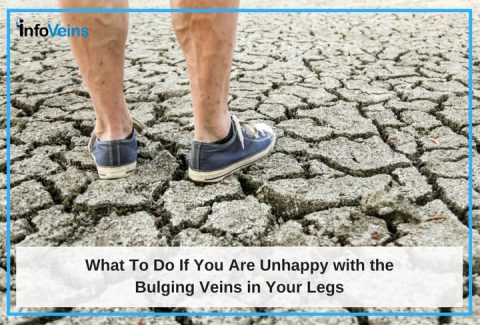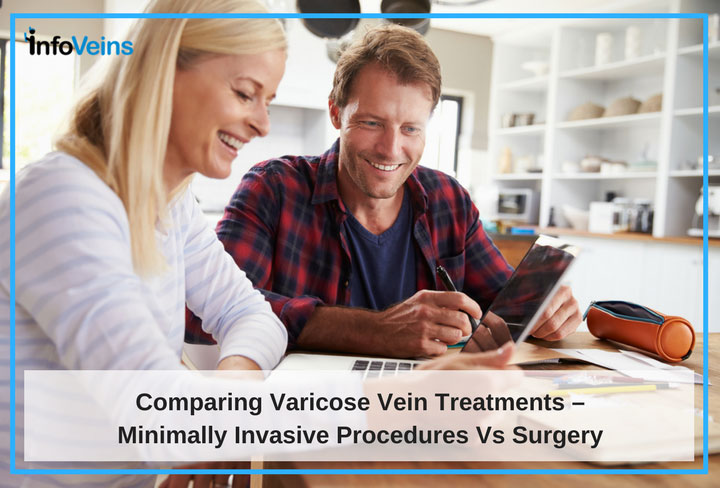
Does thinking about treating varicose veins make you feel overwhelmed? Sometimes it seems there’s so much information, you may never fully understand all your choices, let alone be confident you’re choosing the best option.
If you’re looking for a quick summary of your treatment options, this is the article for you. Let’s compare the options you have. Here, we’ll cover venous ablation, microphlebectomy, vein stripping and ligation.
Understanding the Basics of Varicose Veins
But first, what are varicose veins?
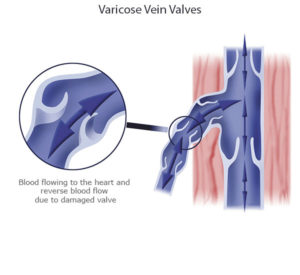
Varicose veins are blue, twisted and bulging veins that develop when the one-way valves that prevent the blood from flowing backward are no longer working properly. When these valves become incompetent, blood pools in the vein, which stretches out the vein walls. The vein walls may not be strong enough to handle the pressure, and the resulting enlargement becomes a varicose vein.
The Goal of Treating Varicose Veins: The goal of any varicose vein treatment is to close off or remove the varicose veins so blood can redirect to healthier veins.
While largely cosmetic, varicose veins can cause medical complications. You may want to consider treatment if you have any of these problems related to your varicose veins:
- Heaviness or discomfort in your legs
- Swelling in your feet or legs
- Burning or throbbing in your legs
- Itching and skin changes around a varicose vein
- Problems with bleeding
- Blood clots now or in the past
- An ulcer or sore that is not going away
Treating Varicose Veins
Most insurance plans will require you to try conservative treatments first. These non-invasive methods can include wearing compression stockings, elevating your legs throughout the day, losing weight if you are overweight or obese, and exercising regularly. If you still have issues with your varicose veins after trying these conservative treatments, then the next step is to find out which treatment may be right for you.
Minimally Invasive Options
Venous ablation and microphlebectomy are minimally invasive options for treating varicose veins. Interventional Radiologists are doctors who are specifically trained in using imaging, such as ultrasound, to treat varicose veins without surgery. Here are some specifics about these procedures:
- Venous ablation – A thin tube, or a catheter, is inserted into the varicose vein. The path of the catheter is followed using ultrasound, and once the tip is in the correct position, heat, made by either a laser fiber or radiofrequency waves, is applied to the inside of the vein. The result is that the vein will close off and eventually disappear.
- Microphlebectomy – This is also called ambulatory phlebectomy. Small nicks are made in the skin around the vein. A specialized instrument is inserted through the incisions and into the affected veins which are then removed. Microphlebectomy is often done along with venous ablation as part of an overall treatment plan. ii
Pros of Minimally Invasive Options
- These treatments are effective
- Endoscopic venous ablation is effective 91-100% of the time
- These are outpatient procedures that can be performed outside of a hospital
- You will not need stitches
- Usually, the only anesthesia needed is an injection of a local anesthetic iv
Cons of Minimally Invasive Options
- Your varicose veins may not be treatable with minimally invasive procedures. Make sure to talk to your doctor about your options
- You may need additional treatments
- Some common side effects can include bleeding, infection and inflammation of the vein
- Blood clots are a rare complication of endovenous treatment ii,iv
Surgical Treatments – Vein Stripping and Ligation
Your grandmother may have had varicose vein surgery. It has been a treatment option for a long time. Vascular surgeons are trained in the surgical treatment of varicose veins and they perform varicose vein stripping and ligation.
You will need medication to sedate you so you are unconscious during the surgery, and you’ll also need regional anesthesia, where a portion of your body is numbed. An incision is made in your groin and around the blood vessels in your calf. The varicose veins are found and tied off. Then the superficial veins are removed.
Pros of Treating Varicose Veins Surgically
- Considered a safe and effective treatment i
Cons of Surgical Treatment
- Requires sedation, which increases the risk of complications
- The recovery takes longer and is more painful than what most patients experience with minimally invasive procedures
- There is up to a 50% chance of recurrence after 5 years
- A third of people may have nerve injury
- Deep vein thrombosis forms in about 5% of people following surgery – this type of blood clot occurs in the deep veins and can move to the lungs, causing a pulmonary embolism, which is potentially life threatening i,v
You have choices when it comes to the treatment of your varicose veins. You may choose to consult with a physician who performs surgery to discuss your surgical options, or, if you are interested in minimally invasive treatments which involve less discomfort and have a faster recovery, make an appointment to review your medical history with an Interventional Radiologist who is specialized in the use of minimally invasive treatments for varicose veins.
Sources:
ii Radiologyinfo.org, Phlebectomy of Varicose Veins. http://www.radiologyinfo.org/en/info.cfm?pg=Phlebectomy (reviewed 4/13/2016, accessed 12/8/2016)
iii Wittens, C., et al., Editor’s Choice – Management of Chronic Venous Disease, Clinical Practice Guidelines of the European Society for Vascular Surgery. Eur J Vasc Endovasc Surg, 2015. 49: p. 678-737. http://www.ejves.com/article/S1078-5884(15)00097-0/pdf
iv Radiologyinfo.org, Varicose Vein Treatment (Endvenous Ablation of Varicose Veins). http://www.radiologyinfo.org/en/info.cfm?pg=varicoseabl (Reviewed 3/21/2016, accessed 12/8/2016)
v Piazza, G., Varicose Veins. Circulation, 2014. 130: p. 582-587. http://circ.ahajournals.org/content/130/7/582.long

